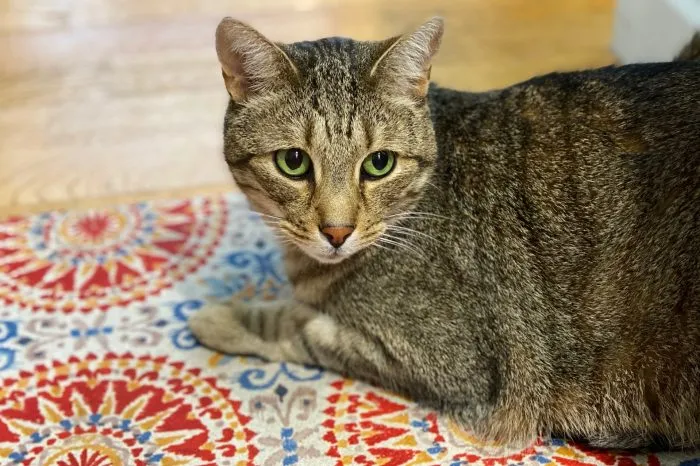Dealing with cats scratching wallpaper and furniture is a common challenge for many cat owners. While it might seem like a destructive habit, understanding the reasons behind it is the first step towards finding effective solutions. This guide will delve into why cats scratch, and provide practical, humane methods to redirect this natural behavior, protecting your home and keeping your feline friend happy.
Understanding Why Cats Scratch
Scratching is an innate and essential behavior for cats. It’s not a sign of spite or defiance, but rather a way for them to maintain their claws, stretch their bodies, and communicate. In the wild, claws are crucial for hunting, climbing, and self-defense. Scratching helps cats shed the old, outer layer of their claws, keeping them sharp and healthy. It also serves as a way to mark their territory through scent glands in their paws, leaving both visual and olfactory signals for other cats. For indoor cats, scratching provides a much-needed outlet for these natural instincts, helping them to relieve stress and feel secure. Some cats even derive pleasure from the physical sensation of scratching, similar to how humans enjoy a good stretch. Recognizing that this behavior is natural is key to managing it effectively, rather than trying to eliminate it entirely.
 A cat's claw extended, about to scratch a fabric surface.
A cat's claw extended, about to scratch a fabric surface.
Redirecting Scratching Behavior with Repellents and Deterrents
Fortunately, there are several humane and effective ways to deter cats from scratching unwanted surfaces like wallpaper and furniture. One popular method is using cat repellent sprays. These sprays are formulated with scents that are generally unpleasant to cats but neutral or pleasant to humans. By applying these sprays to areas where you don’t want your cat to scratch, you can create a barrier that discourages them from visiting those spots. Consistent application is key, as it helps your cat learn to associate the area with an unpleasant experience.
Another simple yet effective deterrent is double-sided tape. Cats generally dislike sticky surfaces, so applying strips of double-sided tape to furniture or wallpaper edges can make these areas unappealing for scratching. The tape provides a harmless physical barrier that discourages the cat without causing them any pain or distress. When the cat attempts to scratch, they encounter the stickiness, which is usually enough to make them retreat and seek an alternative scratching spot. It’s important to test the tape on an inconspicuous area first to ensure it doesn’t damage the surface underneath.
Providing Appropriate Scratching Outlets
The most effective way to stop cats from scratching your wallpaper is to provide them with appealing alternatives. Investing in a good quality scratching post is paramount. A proper scratching post should be tall enough for your cat to fully stretch their body while standing on their hind legs. They come in various materials like sisal rope, cardboard, and carpet, offering different textures that cats may prefer. Offering a variety of scratching posts in different locations and orientations (vertical and horizontal) can further encourage your cat to use them.
Scratcher mats are another excellent option, especially for cats who prefer to scratch horizontally or on flat surfaces. These mats are typically made from durable materials like sisal or corrugated cardboard, designed to withstand vigorous scratching. Many scratcher mats also come with catnip or other attractants to entice your cat to use them. Some mats even have raised edges that can double as a comfortable resting perch, combining scratching and lounging opportunities. By placing these mats in areas your cat frequently visits or already attempts to scratch, you can successfully redirect their energy.
 A woman is on the floor playing with her cat using a feather wand.
A woman is on the floor playing with her cat using a feather wand.
The Importance of Play and Understanding
For indoor cats, boredom can often lead to destructive behaviors, including excessive scratching. Engaging your cat in regular play sessions is crucial for their physical and mental well-being. Interactive toys, such as feather wands or laser pointers (used responsibly), mimic the natural hunting behaviors of cats, helping them expend energy and satisfy their predatory instincts. Consistent playtime not only prevents boredom but also strengthens the bond between you and your cat. A mentally and physically stimulated cat is less likely to seek out your wallpaper for entertainment.
It’s vital to reiterate that scratching is normal cat behavior. Punishing your cat for scratching the wrong things can lead to fear and anxiety, potentially worsening the problem or causing other behavioral issues. Instead of punishment, focus on positive reinforcement when your cat uses their scratching post or mat. Praise them, offer a treat, or engage in a short play session. Understanding and patience are key. By providing appropriate outlets and redirecting their natural instincts, you can effectively protect your home while ensuring your cat remains happy and healthy.
Conclusion
Cats scratch for a variety of natural reasons, from claw maintenance and territory marking to stretching and stress relief. Understanding these motivations is the first step towards managing unwanted scratching behavior. By employing a combination of deterrents like repellent sprays and double-sided tape, and by providing ample, appealing scratching posts and mats, you can effectively redirect your cat’s natural instincts. Regular play sessions are also crucial for indoor cats to prevent boredom and satisfy their need for stimulation. Protecting your furniture and wallpaper doesn’t mean denying your cat a fundamental behavior; it means channeling that behavior appropriately, leading to a happier cat and a more harmonious home.
Discover more wallpaper tips and tricks on the 1ClickWallpapers blog.
